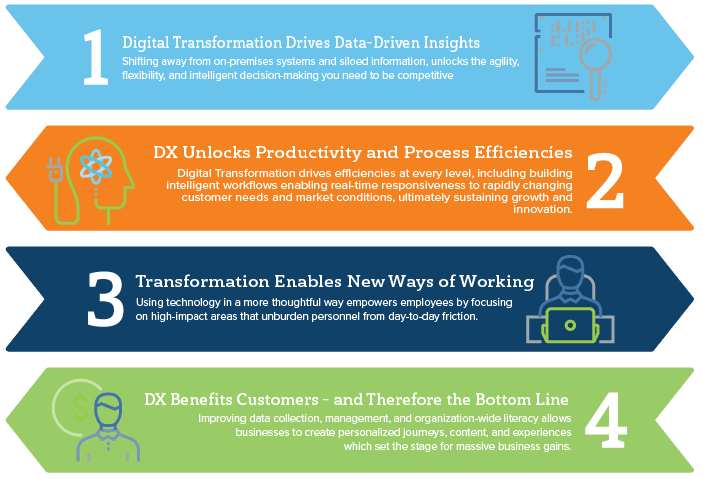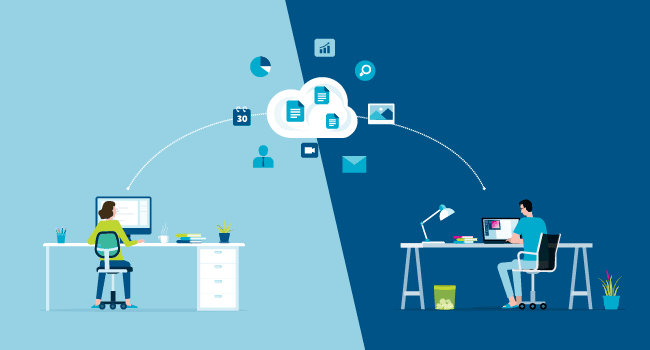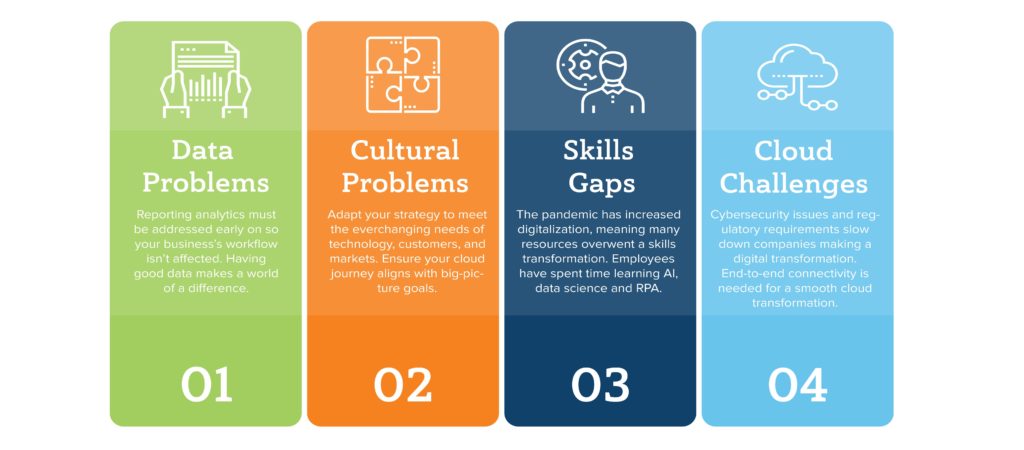Digital Transformation with Dynamics 365
In this article you'll discover the relationship between digital transformation and ERP systems like Dynamics 365
In this article you'll discover the relationship between digital transformation and ERP systems like Dynamics 365
Table of Content
Cloud-based enterprise resource planning (ERP) technologies like Dynamics 365 are at the heart of any digital transformation. They provide the flexibility and baked-in intelligence needed to bring transformations to life.
See, legacy systems have become a barrier to digital transformation. Digital transformation improves the customer experience, streamlines operations, and drives sustainable growth.
They lack the integration capabilities you’ll find in the cloud. This creates silos between teams—making it hard to align around a unified strategy and deliver a consistent experience.
4 Business Benefits of Digital Transformation:

On-premises ERPs inhibit data literacy–and by extension, growth and agility. They make it hard to automate manual tasks and crumble under the weight of massive, ever-expanding data sets.
By contrast, cloud ERPs represent the first step in the digital transformation journey. Out of the box, you’ll gain access to AI reporting tools, automations, and a data ecosystem that spans the entire business.
But, we should note: digital transformation and ERP modernization are not the same.
It’s better to look at the ERP as the foundation that supports the large-scale, complex initiatives you need to gain a competitive advantage.
Here, we’ll discuss the relationship between digital transformation and ERP systems like Dynamics 365.
When you think of “digital transformation” you probably think of technologies like AI, machine learning, the IoT, and so on.
Upgrading the tech stack is, of course, a key part of transformation. But so is modernizing your organization’s processes, culture, business models, and workflows. All things that happen in the ERP.
But we should mention that “digital transformation” isn’t a specific strategy. It’s an ongoing process that uses technology to improve business offerings, operations, and outcomes.
So, if you’re implementing a solution like D365, you’ll want to set it up so that you can add new capabilities and adapt business processes to take advantage of many future transformations.
In these next few sections, we’ll go over some of the more specific ways that ERPs support digital transformation.
Advanced analytics, business intelligence (BI), and visual reporting tools are all essential to any transformation effort. These capabilities allow you to leverage data to drive specific outcomes.
According to Sreepathy Nagarajan, Practice Director, F&O, “Data is the new gold. Today, data literacy is a prerequisite for achieving growth. Data mining and real-time analytics are crucial for competing in today’s economy.”
Senior executives track high-level KPIs—across all business areas. Then, they use those insights to define the business strategy and make decisions that can have a significant impact on the bottom line.
Beyond the C-suite, cloud ERPs set the stage for transformation at every level by bringing actionable insights to the whole organization.
Sr. Client Sales Manager, Lawrence Edwards says, “accessibility is a key element of digital transformation. Making processes and data accessible to everyone unlocks the flexibility you need to change with your customers and enter new markets.”
“D365’s transformative power comes from its all-around accessibility. That–and the fact that cloud solutions lend themselves to more robust integrations with other cloud systems.” – Anthony Dossier, BC Support Engineer
Automation and AI analytics make it easy to analyze more data points, model different scenarios, and take the right action at the right time.
For example, Ste. Michelle Wine Estates deployed D365 Commerce across all brands and channels to boost sales, loyalty, and create a cohesive experience that spans physical and digital touchpoints. One of our clients, NWS, leveraged the benefits of Azure and D365 CRM to enhance billing, inventory management, and order processing strategies. That said, our experts worked with the NWS team to migrate on-prem GP data, establish a standard sales process, and organize data.
Good data is also a prerequisite for automation–which is also becoming a critical competency for enterprises and SMBs alike.
Xerox research found that 80% of SMBs believe that automation is critical to their survival and 82% said they felt the same way—regarding digitizing paperwork. Since the onset of the pandemic, roughly 66% made plans to upgrade automation tools. Additionally, 75% noticed an increased reliance on workflow solutions—with 65% reporting that they’ve already invested in upgrades.
But none of this is possible without the ERP–your company’s “single source of truth.”
Melissa Herbst, Industry Account Executive says, “most of the clients I work with are ready to change. And often, they seek changes because they’re running into growth barriers. As they grow, they recognize the limitations of their current systems and the constraints caused by operational silos.”
“I don’t think I’ve ever had a client actually say they want to modernize. Rather, they come looking for ways to improve operations. In a lot of cases, growth comes from expanding product and service offerings to better meet customer needs. Modernization and access to information are what helps them better achieve their goals.” – Melissa Herbst, Industry Account Executive
Deloitte 2021 Tech Trends report, points out that, today, everyone has access to similar technologies. So, your strategy becomes about how to leverage specific technologies to achieve a specific goal.
The ERP enables organizations to pursue projects that can help them grow.
For example, this case study explains how Albemarle, a chemical company, implemented a new ERP for core modernization. They first focused on building a strong foundation—starting with an out-of-the-box installation. Later, they used APIs and extensions to customize the platform to fit their internal processes.
The ERP was an initial steppingstone that then enabled them to focus on more complex initiatives. In this case, using robotic process automation (RPA) and IT/OT convergence to improve manufacturing.
Consolidated, connected ERPs like Dynamics 365 make it easy to access essential data and business tools from anywhere.
According to Forrester’s 2022 Predictions report, just 10% of companies will go all-in on remote work. But–an estimated 60% will embrace some type of hybrid model.

Analysts predict that a third of organizations will fail on their first attempt at supporting “anywhere work.” They anticipate companies will try to use the virus–or remote work, in general–as a scapegoat. In reality, remote/hybrid work fails when organizations don’t invest in the tools, training, or cultural changes that make it work.
When you’re working with a fragmented tech stack, there’s a risk that different teams are working with different data. This creates confusion for customers, undermines brand compliance, and hinders decision-making abilities.
Gaps in your stack can also create friction in day-to-day workflows. Employees might have trouble finding critical information about a customer or account.
It’s also a security risk. It’s harder for IT to account for all connected data sources.
This means they can’t lock down every endpoint or vulnerability–no matter how thorough they are.
“Cloud ERPs improve the organization’s ability to collaborate by securely sharing company data and knocking down silos.” With D365, organizations gain a unified experience across all departments—finance, sales, marketing, HR, etc. – Jeff Smith, Pre-Sales Engineer
What’s more, Microsoft recently added more tools to Teams that support remote or hybrid work–including secure access to Dynamics 365.
Cloud ERP or not, digital transformation isn’t easy. Below, we’ll run through some of the key challenges organizations face when implementing a digital transformation-ready ERP:

Account Executive, Sam Miller says the role of the ERP “is up to the customer.” He says, “our clients are aware that we recommend addressing reporting analytics early on. They also know that Dynamics offers a world-class workflow capability. We recommend transforming processes but then everyone gets down into the details and we never come up for air.”
But it matters if you’re revamping reports or automating the production line, transformation can’t happen without good data.
The Deloitte report mentioned above warns against making tech investments on assumptions or what you “think” you should be doing. Projects should instead be informed by real business cases–and backed up with real data.
According to HBR, digital transformation involves capturing and understanding massive amounts of unstructured data. You’ll need to integrate proprietary insights with external data and use that information to achieve specific outcomes.
Analysts noted that while most companies understand the importance of data, they often blame IT when the data strategy falls apart.
Many organizations struggle with ERP transformations due to lack of clarity around strategic objectives and business practices.
Digital transformation is more than optimizing workflows and adding AI to your dashboards. It’s about building a data-driven culture and an agile, resilient brand–all of which demand more effort from humans than bots.
Skills shortages were already a huge challenge before the pandemic.
In a recent report, Gartner points out that while the velocity and scale of digitalization were already driving major skills shifts, the pandemic accelerated those trends. 60% of respondents reported undergoing some type of skills transformation post-COVID.
Still, companies struggle with data literacy, skills training, and culture. They also have trouble attracting talent with experience in critical areas like AI, data science, and RPA.
Per a 2020 IBM Institute for Business Value (IBV) survey, 40% of CEOs said they had the resources, talent, and skills needed to execute “transformational strategies.” Those strategies include things like leveraging AI/ML, automating processes, and operationalizing data.
Another challenge is future-proofing your current workforce. It’s not sustainable to hire new people every time there’s a need for a new set of skills. Organizations will instead need to build talent pipelines to sustain gains and avoid future skills gaps.
A 2021 Cloud Infrastructure Report found that 57% of IT leaders say at least half of their infrastructure is already in the cloud. Over 60% plan on being fully cloud-based within the next five years.
It’s clear that businesses are making progress on this front. But—they’re also running into roadblocks preventing true digital transformation from happening.
Top barriers include cybersecurity challenges, regulatory requirements, and governance issues—areas that represent massive (and expensive) risks. Business leaders also cited departmental silos, a lack of app support, and missing/messy/fragmented data sets.
While it’s fine to approach the migration process in phases, transformation requires end-to-end connectivity.
The bottom line is, the relationship between ERP and digital transformation is an important one.
But ERP modernization always comes first–across the board–regardless of size, sector, or strategy.
Without unified data, optimized processes, and remote collaboration tools, transformation can’t happen. Instead, your initial focus should center on building a strong foundation. Then, you can start looking at the data to find opportunities to apply more sophisticated solutions.
Whether you’re migrating an on-prem legacy system to the cloud or need help taking business processes to the next level—Velosio experts can help.
We’ll help you jump start your ERP modernization efforts so you can start focusing on transforming your business. Ready to get started on your Digital Transformation? Read more about the process here.
How To Begin Your Digital Transformation